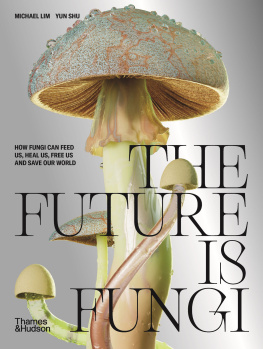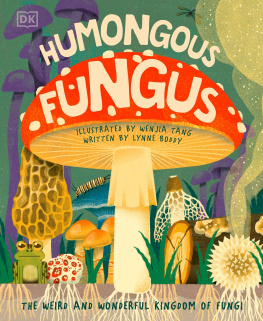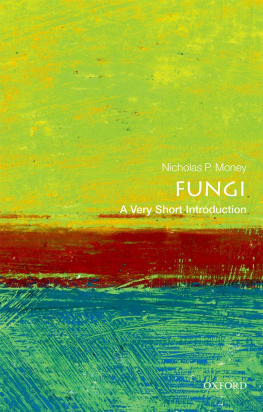Table of Contents
Guide
Page List
FUNGI
THE
LIVES
OF
A NATURAL HISTORY OF OUR PLANETS DECOMPOSERS
Britt A. Bunyard
PRINCETON UNIVERSITY PRESS
PRINCETON AND OXFORD
Published by Princeton University Press
41 William Street, Princeton, New Jersey 08540
99 Banbury Road, Oxford OX2 6JX
press.princeton.edu
Copyright 2022 UniPress Books Limited
www.unipressbooks.com
All rights reserved. No part of this book may be reproduced
or transmitted in any form or by any means, electronic or
mechanical, including photocopying, recording, or by any
information storage-and-retrieval system, without written
permission from the copyright holder. Requests for permission
to reproduce material from this work should be sent to
permissions@press.princeton.edu
Library of Congress Control Number 2021949362
ISBN 978-0-691-22984-3
Ebook ISBN 978-0-691-23035-1
Typeset in Bembo and Futura
Printed and bound in China
10 9 8 7 6 5 4 3 2 1
British Library Cataloging-in-Publication Data is available
This book was conceived, designed, and produced by
UniPress Books Limited
Publisher: Nigel Browning
Commissioning editor: Kate Shanahan
Project manager: Natalia Price-Cabrera
Art direction: Wayne Blades
Designer: Gilda Pacitti
Picture researcher: Natalia Price-Cabrera
Illustrator: Sarah Skeate
Cover photograph Anne Powell/Shutterstock
INTRODUCTION
WHAT ARE FUNGI ?
REPRODUCTION
CHEMISTRY AND PHYSIOLOGY
SAPROBES AND PARASITES
PATHOGENS, PANDEMICS,
AND SCOURGES
MUTUALISTIC SYMBIONTS
FUNGI AND HUMANS
FUNGI AND THE FUTURE
278 Glossary
282 Useful resources
283 Index
288 Acknowledgments
CONTENTS
INTRODUCTION
INTRODUCTION
Everything depends on everything else.
(Translated credo of the Haida people of the Pacific Northwest)
A
ll life on the planet is connected, but these
connections go mostly unseen.As you read this,
for example,microbes covering much of the
surface of your bodyinside and outare going about
their business.In fact,the vast majority of living cells that
make the ecosystem that isyouare not human;the vast
majority are microbial,and some are fungal.
Its a similar story with the tree outside your
window, which is mostly of non-living tree cells; most
of the living cells making up that tree are probably not
tree or even plant cells. Endophytic organisms inside
the plants tissues are responsible for much of the
hormonal control of the plant, determining its
drought resistance, heat resistance, and toxin production
in response to attack by pathogens or herbivory.
Mycorrhizae of the trees roots are responsible for the
uptake of water and nutrients.These fungi are attached
to adjacent and unrelated trees, and have fruitbodies
that host fungi-eating (mycophagous) arthropods.These
arthropods are in turn parasitized by nematodes, or by
smaller arthropods, such as braconid parasitoid wasps.
Those tiny parasitoid wasps rely on viruses to mask
their invading parasite egg from the immune system
of the hosts larva, and so the connections go on.
What all of these living organisms have in common,
thoughindeed, what every living organism on this
planet has in commonis a reliance on fungi.Yet even
though fungi are all around us, they remain poorly
understood.With our planet and natural resources
under constant assault from an ever-shrinking habitat
and a burgeoning human population that brings with it
pollution, invasive species, and other manmade disasters,
it is becoming increasingly important that we are aware
of the natural treasures that exist all around us.
Mushrooms and other fungi are beautiful and
interesting organisms, which I know is an opinion
that is not shared by everyone. If considered at all,
fungi are often seen as mere recyclers of nutrients and
decomposers of organic matter in the environment
rotters of the once-living. However, recently developed
methods to detect organismal DNA from the
environment, improved microscopic techniques,
and novel methods for culturing and cultivating,
are showing that fungi are much more ubiquitous than we thought.They are
also revealing that fungi are much more important to the environment and,
by extension, to ourselves.
Based on sheer mass and the number of species, fungi (along with insects)
are likely the most common and most evolutionarily successful organisms on
the planet. Fungi can be found thriving on all continents of Earth, from the
loftiest peaks to the driest deserts, from the depths of the worlds oceans to
our own backyards. Nor do they stop at our doorsthey can be found thriving
(to the chagrin of most) within our own homes.With advances in modern
microscopy we have come to know that molds and other fungi are found in
just about every niche in the environment and that probably no plantslong
considered the keystones of all habitatscan thrive for very long without their
Favolaschia calocera is a beautiful
rotter of wood that has recently been
turning up in many new places and
new habitats. A changing climate
and international travel and trade are
changing the mycological landscapes
around us.
Mushrooms are the reproductive
structures of fungi and come in a
bewildering assortment of shapes
and forms. The Common Splitgill
( Schizophyllum commune ) is one
of the most ubiquitous of all mushrooms,
found on dead wood of every continent
except Antarctica.
fungal partners. Obligately intertwined among roots
as mycorrhizae, growing epiphytically on plant surfaces,
and found within plant tissues as endophytes, fungi are
the true puppet masters in nature. Conversely, fungi
also cause the vast majority of disease among plant
species, including those to which we owe our very
survival as sources of food, fi ber, and medicines; again,
fungi pull the strings.
As a species, we humans have come to a crucial
point in our history.About 2.5 billion people inhabited
our planet when I was born, but by the early 1990s,
when I was a graduate student studying mushrooms
and other fungi, our population had increased to 5.3
billion. Now that number is 7.8 billion, which is
projected to rise to 9.7 billion by 2050.These snowballing
fi gures highlight the immense challenges we face when
tackling global climate change and fi guring out how,
as a species, we can sustain the healthy ecosystems that
we depend on for our existence.
There is no doubt that fungi will play an important
role in this process, as humans have collected, used,
and eaten mushrooms and other fungi for (arguably)









